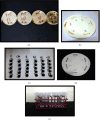Enhancing Presurgical Infant Orthopedic Appliances: Characterization, Mechanics, and Biofilm Inhibition of a Novel Chlorhexidine-Halloysite Nanotube-Modified PMMA
- PMID: 38962288
- PMCID: PMC11221949
- DOI: 10.1155/2024/6281972
Enhancing Presurgical Infant Orthopedic Appliances: Characterization, Mechanics, and Biofilm Inhibition of a Novel Chlorhexidine-Halloysite Nanotube-Modified PMMA
Abstract
Objectives: This in vitro study aimed to develop a novel nanocomposite acrylic resin with inherent antimicrobial properties. This study evaluated its effectiveness against microbial biofilm formation, while also assessing its physical and mechanical properties.
Methods: Polymethylmethacrylate (PMMA) was modified with four different concentrations of chlorhexidine halloysite nanotubes (CHX-HNTs): 1%, 1.5%, 3%, and 4.5 wt.% by weight, along with a control group (0 wt.% CHX-HNTs). The biofilm inhibition ability of the modified CHX-HNTs acrylic against Candida albicans, Staphylococcus aureus, Streptococcus pneumoniae, and Streptococcus agalactiae was assessed using microtiter biofilm test. In addition, ten samples from each group were then tested for flexural strength, surface roughness, and hardness. Statistical analysis was performed using one-way ANOVA and Tukey's test for comparison (P < 0.05).
Results: CHX-HNTs effectively reduced the adhesion of Candida albicans and bacteria to the PMMA in a dose-dependent manner. The higher the concentration of CHX-HNTs, the greater the reduction in microbial adhesion, with the highest concentration (4.5 wt.%) showing the most significant effect with inhibition rates ≥98%. The addition of CHX-HNTs at any tested concentration (1%, 1.5%, 3%, and 4.5 wt.%) did not cause any statistically significant difference in the flexural strength, surface roughness, or hardness of the PMMA compared to the control group.
Conclusions: The novel integration of CHX-HNT fillers shows promising results as an effective biofilm inhibitor on acrylic appliances. This new approach has the potential to successfully control infectious diseases without negatively affecting the mechanical properties of the acrylic resin. Clinical Relevance. The integration of CHX-HNTs into presurgical infant orthopedic appliances should be thoroughly assessed as a promising preventive measure to mitigate microbial infections. This evaluation holds significant potential for controlling infectious diseases among infants with cleft lip and palate, thereby offering a valuable contribution to their overall well-being.
Copyright © 2024 Nadia Al Ansari and Mushriq Abid.
Conflict of interest statement
The authors declare that they have no conflicts of interest.
Figures









Similar articles
-
Falls prevention interventions for community-dwelling older adults: systematic review and meta-analysis of benefits, harms, and patient values and preferences.Syst Rev. 2024 Nov 26;13(1):289. doi: 10.1186/s13643-024-02681-3. Syst Rev. 2024. PMID: 39593159 Free PMC article.
-
Depressing time: Waiting, melancholia, and the psychoanalytic practice of care.In: Kirtsoglou E, Simpson B, editors. The Time of Anthropology: Studies of Contemporary Chronopolitics. Abingdon: Routledge; 2020. Chapter 5. In: Kirtsoglou E, Simpson B, editors. The Time of Anthropology: Studies of Contemporary Chronopolitics. Abingdon: Routledge; 2020. Chapter 5. PMID: 36137063 Free Books & Documents. Review.
-
Comparison of Two Modern Survival Prediction Tools, SORG-MLA and METSSS, in Patients With Symptomatic Long-bone Metastases Who Underwent Local Treatment With Surgery Followed by Radiotherapy and With Radiotherapy Alone.Clin Orthop Relat Res. 2024 Dec 1;482(12):2193-2208. doi: 10.1097/CORR.0000000000003185. Epub 2024 Jul 23. Clin Orthop Relat Res. 2024. PMID: 39051924
-
Antioxidants for female subfertility.Cochrane Database Syst Rev. 2020 Aug 27;8(8):CD007807. doi: 10.1002/14651858.CD007807.pub4. Cochrane Database Syst Rev. 2020. PMID: 32851663 Free PMC article.
-
Trends in Surgical and Nonsurgical Aesthetic Procedures: A 14-Year Analysis of the International Society of Aesthetic Plastic Surgery-ISAPS.Aesthetic Plast Surg. 2024 Oct;48(20):4217-4227. doi: 10.1007/s00266-024-04260-2. Epub 2024 Aug 5. Aesthetic Plast Surg. 2024. PMID: 39103642 Review.
References
-
- McNEIL C. K. Orthodontic procedures in the treatment of congenital cleft palate. Dent Rec (London) . 1950;70(5):126–132. - PubMed
-
- Hosseini H. R., Kaklamanos E. G., Athanasiou A. E. Treatment outcomes of pre-surgical infant orthopedics in patients with non-syndromic cleft lip and/or palate: a systematic review and meta-analysis of randomized controlled trials. PLoS One . 2017;12(7) doi: 10.1371/journal.pone.0181768. - DOI - PMC - PubMed
-
- Mahmood S. D., Al-Mulla A. A. Incidence of cleft lip and palate in Al-ramadi city (descriptive epidemiological study) Journal of Baghdad College of Dentistry . 2016;28(2):139–144. doi: 10.12816/0028237. - DOI
LinkOut - more resources
Full Text Sources

